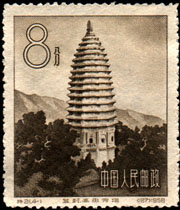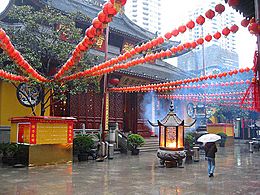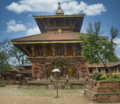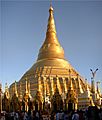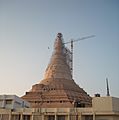Pagoda facts for kids
A pagoda is any kind of tower with multiple eaves. They are common in eastern and southeastern Asia.
Most pagodas are built for religious purposes. They are usually Buddhist. Some are used as Taoist temples.
The modern design for pagodas comes from the stupas of ancient Nepal. These were first built during the 3rd century BC. This kind of architecture has spread across Asia, taking on many differences as details specific to different regions are made a part of the overall design.
Stupas were used to house Buddhist relics. Later, the architecture of Chinese towers and Chinese pavilions blended into pagoda architecture. This eventually spread to Southeast Asia. The pagoda's original purpose was to house relics and sacred writings.
Contents
Architecture
Pagodas come in many different sizes, with taller ones often attracting lightning strikes. While this has inspired tradition that the finial decorating the top of the structure can seize demons, the historically frequent damage has often motivated the modern addition of conductive wires connecting the finial to the earth, allowing it to function as a true lightning conductor.
Pagodas traditionally have an odd number of levels, a notable exception being the eighteenth century pagoda designed by Sir William Chambers at the Royal Botanic Gardens, Kew, London.
The pagodas in Myanmar, Thailand, Laos and Cambodia are very different from Chinese and Japanese pagodas. Pagodas in these countries are derived from Dravidian architecture.
Construction materials
Wood
During the Southern and Northern Dynasties pagodas were mostly built of wood, as were other ancient Chinese structures. Wooden pagodas are resistant to earthquakes, however many have burnt down, and wood is also prone to both natural rot and insect infestation.
Examples of wooden pagodas:
- White Horse Pagoda at White Horse Temple, Luoyang.
- Futuci Pagoda in Xuzhou, built in the Three Kingdoms period (c. 220–265).
- Many of the pagodas in Stories About Buddhist Temples in Luoyang, a Northern Wei text, were wooden.
The literature of subsequent eras also provides evidence of the domination of wooden pagoda construction in this period. The famous Tang Dynasty poet, Du Mu, once wrote:
- 480 Buddhist temples of the Southern Dynasties,
- uncountable towers and pagodas stand in the misty rain.
The oldest extant fully wooden pagoda standing in China today is the Pagoda of Fugong Temple in Ying County, Shanxi Province, built in the 11th century during the Song Dynasty/Liao Dynasty (refer to Architecture section in Song Dynasty).
Transition to brick and stone
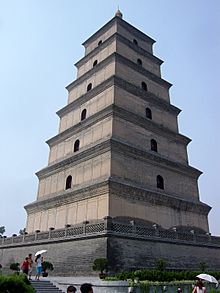
During the Northern Wei and Sui dynasties (386–618) experiments began with the construction of brick and stone pagodas. Even at the end of the Sui, however, wood was still the most common material. For example, Emperor Wen of the Sui Dynasty (reigned 581–604) once issued a decree for all counties and prefectures to build pagodas to a set of standard designs, however since they were all built of wood none have survived. Only the Songyue Pagoda has survived, a circular-based pagoda built out of stone in 523 AD.
Brick
The earliest extant brick pagoda is the 40-metre-tall Songyue Pagoda in Dengfeng Country, Henan. This curved, circle-based pagoda was built in 523 during the Northern Wei Dynasty, and has survived for 15 centuries. Much like the later pagodas found during the following Tang Dynasty, this temple featured tiers of eaves encircling its frame, as well as a spire crowning the top. Its walls are 2.5 m thick, with a ground floor diameter of 10.6 m. Another early brick pagoda is the Sui Dynasty Guoqing Pagoda built in 597.
Stone
The earliest large-scale stone pagoda is a Four Gates Pagoda at Licheng, Shandong, built in 611 during the Sui Dynasty. Like the Songyue Pagoda, it also features a spire at its top, and is built in the pavilion style.
Brick and stone
One of the earliest brick and stone pagodas was a three-storey construction built in the (first) Jin Dynasty (265–420), by Wang Jun of Xiangyang. However, it is now destroyed.
Brick and stone went on to dominate Tang, Song, Liao and Jin Dynasty pagoda construction. An example is the Giant Wild Goose Pagoda (652 AD), built during the early Tang Dynasty. The Porcelain Pagoda of Nanjing has been one of the most famous brick and stone pagoda in China throughout history. The Zhou dynasty started making the ancient pagodas about 3,500 years ago.
De-emphasis over time
Pagodas, in keeping with the tradition of the White Horse Temple, were generally placed in the center of temples until the Sui and Tang dynasties. During the Tang, the importance of the main hall was elevated and the pagoda was moved beside the hall, or out of the temple compound altogether. In the early Tang, Daoxuan wrote a Standard Design for Buddhist Temple Construction in which the main hall replaced the pagoda as the center of the temple.
The design of temples was also influenced by the use of traditional Chinese residences as shrines, after they were philanthropically donated by the wealthy or the pious. In such pre-configured spaces, building a central pagoda might not have been either desirable or possible.
In the Song Dynasty (960–1279), the Chan (Zen) sect developed a new 'seven part structure' for temples. The seven parts—the Buddha hall, dharma hall, monks' quarters, depository, gate, pure land hall and toilet facilities—completely exclude pagodas, and can be seen to represent the final triumph of the traditional Chinese palace/courtyard system over the original central-pagoda tradition established 1000 years earlier by the White Horse Temple in 67. Although they were built outside of the main temple itself, large pagodas in the tradition of the past were still built. This includes the two Ming Dynasty pagodas of Famen Temple and the Chongwen Pagoda in Jingyang of Shaanxi Province.
A prominent, later example of converting a palace to a temple is Beijing's Yonghe Temple, which was the residence of Yongzheng Emperor before he ascended the throne. It was donated for use as a lamasery after his death in 1735.
Styles of eras
Han Dynasty
Examples of Han Dynasty era tower architecture predating Buddhist influence and the full-fledged Chinese pagoda can be seen in the four pictures below. Michael Loewe writes that during the Han Dynasty (202 BC – 220 AD) period, multi-storied towers were erected for religious purposes, as astronomical observatories, as watchtowers, or as ornate buildings that were believed to attract the favor of spirits, deities, and immortals.
-
Ancient Chinese model of two residential towers, made of earthenware during the Han Dynasty, 2nd century BC to 2nd century AD, excavated by archaeologists in 1993
Sui and Tang
Pagodas built during the Sui and Tang Dynasty usually had a square base, with a few exceptions such as the Daqin Pagoda:
Dali kingdom
Song, Liao, Jin, Yuan
Pagodas of the Five Dynasties, Northern and Southern Song, Liao, Jin, and Yuan Dynasties incorporated many new styles, with a greater emphasis on hexagonal and octagonal bases for pagodas:
-
Pagoda of Fogong Temple, built in 1056.
-
The Liaodi Pagoda, built in 1055
-
Pizhi Pagoda, built by 1063.
-
The Chengling Pagoda, built in 1189.
Ming and Qing
Pagodas in the Ming and Qing Dynasties generally inherited the styles of previous eras, although there were some minor variations:
Some notable pagodas
Tiered towers with multiple eaves:
- Dâu Pagoda, Bắc Ninh, Vietnam, built in 187.
- Pashupatinath Temple, Kathmandu, Nepal built in the 5th century.
- Trấn Quốc Pagoda, Hanoi, Vietnam, built in 545.
- Songyue Pagoda on Mount Song, Henan, China, built in 523.
- Mireuksa at Iksan, Korea, built in the early 7th century.
- Bunhwangsa at Gyeongju, Korea, built in 634.
- Xumi Pagoda at Zhengding, Hebei, China, built in 636.
- Daqin Pagoda in China, built in 640.
- Hwangnyongsa Wooden nine-story pagoda on Hwangnyongsa, Gyeongju, Korea, built in 645.
- Pagoda at Hōryū-ji, Ikaruga, Nara, Japan, built in the 7th century.
- Giant Wild Goose Pagoda, built in Xi'an, China in 704
- Small Wild Goose Pagoda, built in Xi'an, China in 709.
- Seokgatap on Bulguksa, Gyeongju, Korea, built in 751.
- Dabotap on Bulguksa, Gyeongju, Korea, built in 751.
- Tiger Hill Pagoda, built in 961 outside of Suzhou, China
- Lingxiao Pagoda at Zhengding, Hebei, China, built in 1045.
- Iron Pagoda of Kaifeng, built in 1049, during the Song dynasty.
- Liaodi Pagoda of Dingzhou, built in 1055 during the Song dynasty
- Pagoda of Fogong Temple, built in 1056 in Ying County, Shanxi, China.
- Pizhi Pagoda of Lingyan Temple, Shandong, China, 11th century.
- Beisi Pagoda at Suzhou, Jiangsu, China, built in 1162.
- Liuhe Pagoda of Hangzhou, built in 1165, during the Song dynasty.
- Ichijō-ji, Kasai, Hyōgo, Japan, built in 1171.
- The Porcelain Tower of Nanjing, built between 1402 and 1424, a wonder of the medieval world in Nanjing, China.
- Tsui Sing Lau Pagoda in Ping Shan, Hong Kong, built in 1486.
- Dragon and Tiger Pagodas in Kaohsiung, Taiwan, built in 1976.
- Seven-storey Pagoda in Chinese Garden at Jurong East, Singapore, built in 1975.
- Pazhou Pagoda on Whampoa (Huangpu) Island, Guangzhou (Canton), China, built in 1600.
- Pagoda of the Celestial Lady, in Huế, Vietnam, built in 1601.
- Palsangjeon, a five-story pagoda at Beopjusa, Korea built in 1605.
- Tō-ji, the tallest wooden structure in Kyoto, Japan, built in 1644.
- Nyatapola at Bhaktapur, Kathmandu Valley built during 1701–1702.
- The Great Pagoda at Kew Gardens, London, UK, built in 1762.
- Reading Pagoda of Reading, Pennsylvania, built in 1908.
- Kek Lok Si's main pagoda in Penang, Malaysia, exhibits a combination of Chinese, Burmese and Thai Buddhist architecture, built in 1930.
- The pagoda of Japan Pavilion at Epcot, Florida, built in 1982.
- Pagoda of Tianning Temple, the tallest pagoda in the world since its completion in April 2007, stands at 153.7 m in height.
- Nepalese Peace Pagoda in Brisbane, Australia built for the World Expo '88.
- Pagoda Avalokitesvara, Indonesia, tallest pagoda in Indonesia, stands at 45 meters built in 2004.
- Sun and Moon Pagodas in Guilin, Guangxi, China, twin pagodas on Shan Lake, originally built in the 10th century and reconstructed using historical description on the original foundation in 2001.
Stupas called "pagodas":
- Global Vipassana Pagoda, the largest unsupported domed stone structure in the world.
- Mingun Pahtodawgyi, a monumental uncompleted stupa began by King Bodawpaya in 1790. If completed, it would be the largest in the world at 150 meters.
- Pha That Luang, the holiest wat, pagoda, and stupa in Laos, in Vientiane
- Phra Pathommachedi the highest pagoda or stupa in Thailand Nakhon Pathom, Thailand.
- Shwedagon Pagoda, a 98-metre (322 ft) gilded pagoda and stupa located in Yangon, Myanmar. It is the most sacred Buddhist pagoda for the Burmese with relics of the past four Buddhas enshrined within.
- Shwezigon Pagoda in Nyaung-U, Myanmar. Completed during the reign of King Kyanzittha in 1102, it is a prototype of Burmese stupas.
- Uppatasanti Pagoda, a 325-foot tall landmark in Naypyidaw, Myanmar, built from 2006 to 2009, which houses a Buddha tooth relic.
Places called "pagoda" but which are not tiered structures with multiple eaves:
- One Pillar Pagoda: Hanoi, Vietnam, is an icon of Vietnamese culture; it was built in 1049, destroyed, and rebuilt in 1954.
Structures that evoke pagoda architecture:
- The Dragon House of Sanssouci Park, which is an eighteenth-century German attempt at imitating Chinese architecture.
- The Panasonic Pagoda, or Pagoda Tower, at the Indianapolis Motor Speedway. This 13-story pagoda, used as the control tower for races such as the Indy 500, has been transformed several times since it was first built in 1913.
- Jin Mao Tower in Shanghai, built between 1994 and 1999.
- Petronas Towers in Kuala Lumpur, the tallest buildings in the world from 1998 to 2004
- Taipei 101 in Taiwan, record setter for height (508m) in 2004 and currently the world's fourth tallest completed building.
Structures not generally thought of as pagodas, but which have some pagoda-like characteristics:
- The Hall of Prayer for Good Harvests at the Temple of Heaven
- Wongudan Altar in Korea
Images for kids
-
The Liuhe Pagoda (Six Harmonies Pagoda) of Hangzhou, Zhejiang, China, built in 1165 AD during the Song dynasty.
-
Giant Wild Goose Pagoda of Xi'an in China, built in the 7th century, made of brick.
-
Phước Duyên Pagoda in Thiên Mụ Temple Vietnam, built in 1844 on the order of the Thiệu Trị emperor.
-
Seokgatap of Bulguksa in South Korea, built in the 8th century, made of granite. In 1966, the Mugujeonggwang Great Dharani Sutra, the oldest extant woodblock print and several other treasures were found in the second story of this pagoda.
-
The Lingxiao Pagoda of Zhengding, Hebei, built in 1045 AD during the Song dynasty, with little change in later renovations.
-
The Xumi Pagoda, built in 636 AD during the Tang dynasty.
-
The Iron Pagoda of Kaifeng, China, built in 1049
-
One Pillar Pagoda, Hanoi, Vietnam.
-
The nine-story Xumi Pagoda, Hebei, China, built in 636
-
Taipei 101 in Taipei, Taiwan
-
The Bombardier Pagoda at the Indianapolis Motor Speedway
-
Shwedagon Pagoda located in Yangon, Myanmar. The whole structure is coated with 60 tons of pure gold
See also
 In Spanish: Pagoda para niños
In Spanish: Pagoda para niños



